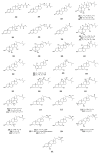Microbial Sterolomics as a Chemical Biology Tool
- PMID: 30366429
- PMCID: PMC6278499
- DOI: 10.3390/molecules23112768
Microbial Sterolomics as a Chemical Biology Tool
Abstract
Metabolomics has become a powerful tool in chemical biology. Profiling the human sterolome has resulted in the discovery of noncanonical sterols, including oxysterols and meiosis-activating sterols. They are important to immune responses and development, and have been reviewed extensively. The triterpenoid metabolite fusidic acid has developed clinical relevance, and many steroidal metabolites from microbial sources possess varying bioactivities. Beyond the prospect of pharmacognostical agents, the profiling of minor metabolites can provide insight into an organism's biosynthesis and phylogeny, as well as inform drug discovery about infectious diseases. This review aims to highlight recent discoveries from detailed sterolomic profiling in microorganisms and their phylogenic and pharmacological implications.
Keywords: algal sterols; ergosterol biosynthesis; infectious disease; lipidomics; oxyphytosterol; pharmacognosy; phytosterol; sterolomics.
Conflict of interest statement
The author declares no conflict of interest.
Figures
















Similar articles
-
Sterol Biosynthesis in Four Green Algae: A Bioinformatic Analysis of the Ergosterol Versus Phytosterol Decision Point.J Phycol. 2021 Aug;57(4):1199-1211. doi: 10.1111/jpy.13164. Epub 2021 May 20. J Phycol. 2021. PMID: 33713347 Free PMC article.
-
Sterol composition in plants is specific to pollen, leaf, pollination and pollinator.Phytochemistry. 2023 Oct;214:113800. doi: 10.1016/j.phytochem.2023.113800. Epub 2023 Jul 31. Phytochemistry. 2023. PMID: 37532086 Free PMC article.
-
Novel sterol transformations promoted by Saccharomyces cerevisiae strain GL7: evidence for 9 beta, 19-cyclopropyl to 9(11)-isomerization and for 14-demethylation to 8(14)-sterols.Arch Biochem Biophys. 1995 Dec 1;324(1):189-99. doi: 10.1006/abbi.1995.9912. Arch Biochem Biophys. 1995. PMID: 7503554
-
Non-cholesterol Sterols in the Diagnosis and Treatment of Dyslipidemias: A Review.Curr Med Chem. 2016;23(20):2132-45. doi: 10.2174/0929867323666160504104133. Curr Med Chem. 2016. PMID: 27142287 Review.
-
Implication of Oxysterols and Phytosterols in Aging and Human Diseases.Adv Exp Med Biol. 2024;1440:231-260. doi: 10.1007/978-3-031-43883-7_12. Adv Exp Med Biol. 2024. PMID: 38036883 Review.
Cited by
-
Promises and Challenges of Microalgal Antioxidant Production.Antioxidants (Basel). 2019 Jun 27;8(7):199. doi: 10.3390/antiox8070199. Antioxidants (Basel). 2019. PMID: 31252612 Free PMC article.
-
Omics for Bioprospecting and Drug Discovery from Bacteria and Microalgae.Antibiotics (Basel). 2020 May 4;9(5):229. doi: 10.3390/antibiotics9050229. Antibiotics (Basel). 2020. PMID: 32375367 Free PMC article. Review.
-
Beneficial sterols in selected edible insects and their associated antibacterial activities.Sci Rep. 2023 Jul 4;13(1):10786. doi: 10.1038/s41598-023-37905-4. Sci Rep. 2023. PMID: 37402875 Free PMC article.
-
Multi-Omic Profiling of Melophlus Sponges Reveals Diverse Metabolomic and Microbiome Architectures that Are Non-overlapping with Ecological Neighbors.Mar Drugs. 2020 Feb 19;18(2):124. doi: 10.3390/md18020124. Mar Drugs. 2020. PMID: 32092934 Free PMC article.
-
Potential Beneficial Effects and Pharmacological Properties of Ergosterol, a Common Bioactive Compound in Edible Mushrooms.Foods. 2023 Jun 29;12(13):2529. doi: 10.3390/foods12132529. Foods. 2023. PMID: 37444267 Free PMC article. Review.
References
-
- Volkman J.K. Sterols and other triterpenoids: Source specificity and evolution of biosynthetic pathways. Org. Geochem. 2005;36:139–159. doi: 10.1016/j.orggeochem.2004.06.013. - DOI
Publication types
MeSH terms
Substances
LinkOut - more resources
Full Text Sources

